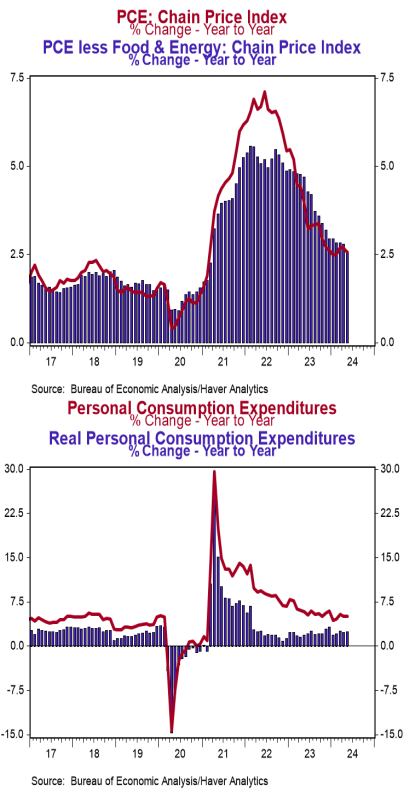- Personal income rose 0.2% in June (+0.1% including revisions to prior months), lagging the consensus expected 0.4%. Personal consumption rose 0.3% in June (+0.5% including revisions), matching consensus expectations. Personal income is up 4.5% in the past year, while spending has increased 5.2%.
- Disposable personal income (income after taxes) rose 0.2% in June and is up 3.6% from a year ago.
- The overall PCE deflator (consumer prices) rose 0.1% in June and is up 2.5% versus a year ago. The “core” PCE deflator, which excludes food and energy, rose 0.2% in June and is up 2.6% in the past year.
- After adjusting for inflation, “real” consumption rose 0.2% in June and is up 2.6% from a year ago.
Implications: The Fed has now received the last key piece of data to be released before their meetings next week, and it looks very likely it will signal that rate cuts will start in September. PCE prices – the Fed’s preferred inflation measure – rose 0.1% in June and is up 2.5% in the past year compared to a 3.2% gain in the year ending in June 2023. “Core” prices, which exclude the ever-volatile food and energy categories, rose 0.2% in June and are up 2.6% versus a year ago, a big improvement from the 4.3% reading for the twelve months ending June 2023. It’s too early to call victory with inflation still above the Fed’s 2.0% target, but the numbers have moved in a positive direction since the last time that the Fed met. Transitioning to a focus on how consumers fared in June shows some moderate growth. Personal income rose 0.2% in June and is up 4.5% in the past year. Private-sector wages and salaries led the way, up 0.2% on the month and up 4.1% in the past year. Unfortunately government activity continues to run hot as well, with government transfer payments rising 0.3% in June while government pay rose 0.6% and is up 8.5% in the past year, marking the largest twelve-month increase in more than three decades. We don’t think the growth in government pay – or massive government deficit spending – is sustainable or good for the US economy. Consumer spending rose 0.3% in June, led by outlays on services which rose 0.4% on the month and are up 6.8% in the past year. Goods spending rose 0.1% in June and is up 2.0% from a year ago. When adjusting for inflation, consumption rose 0.2%. We are closely watching the service sector as the driver of consumer activity both now and in the near future, and we expect activity to temper as elevated interest rates and continued inflation pressure continue to take their toll. We are also keeping an eye on the savings rate (the percent of disposable income that consumers save), which hovered around 6.0% pre-COVID, skyrocketed with the excess money printing during COVID, and has now been hovering around 3.5% over recent months. This shortage in savings will catch up with consumers down the road. In other recent news on the manufacturing front, the Kansas City Fed Manufacturing Index, a measure of factory activity in that region, fell to -13 in July from -8 in June, following a similar negative reading earlier this week from the Richmond Fed. These readings suggest the national ISM report to arrive next Thursday will remain below 50, signaling contraction.





